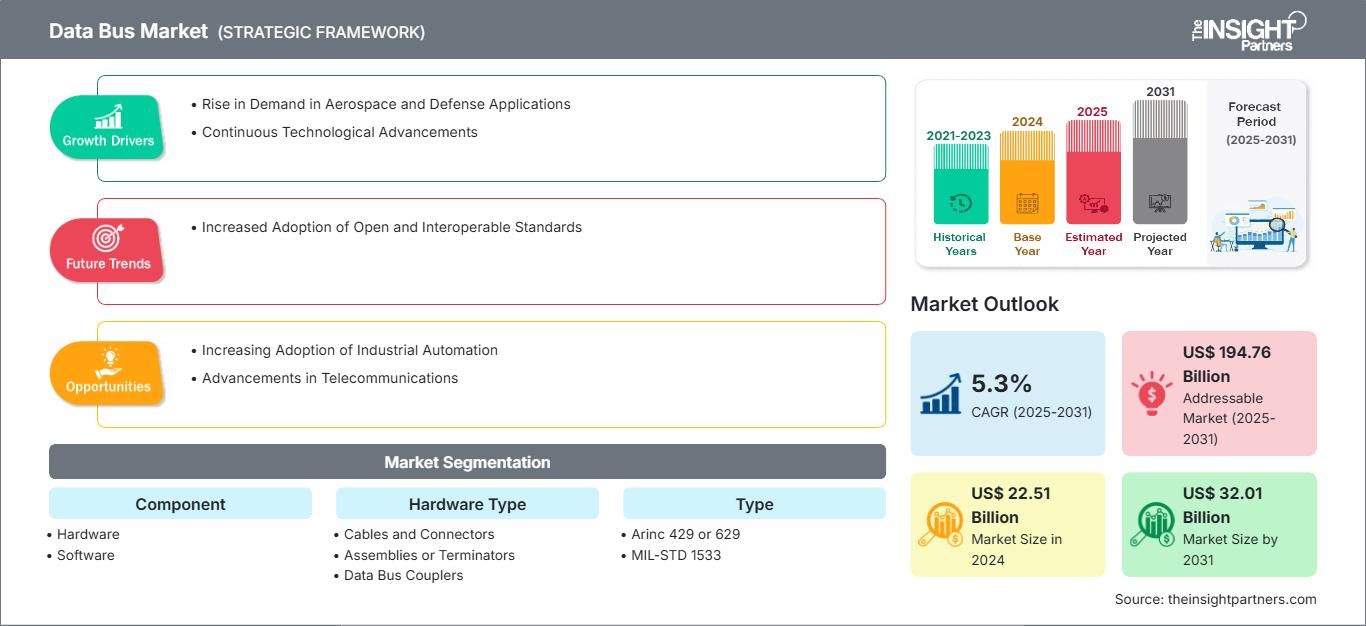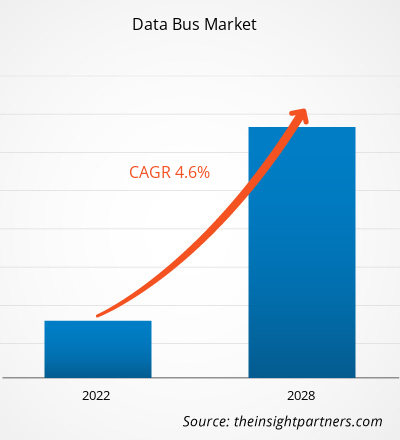2024 年数据总线市场规模为 225.1 亿美元,预计到 2031 年将达到 320.1 亿美元;预计 2025 年至 2031 年期间的复合年增长率为 5.3%。开放和可互操作标准的采用率不断提高,可能会带来新的市场趋势。
数据总线市场分析
航空航天和国防应用需求的增长以及技术的持续进步等因素正在推动数据总线市场的发展。由于工业自动化的日益普及和电信技术的进步,预计市场在预测期内将有所增长。开放和可互操作标准的采用率不断提高,预计将成为市场的主要趋势之一。然而,高昂的实施成本可能会阻碍数据总线市场的增长。
数据总线市场概览
数据总线是计算机或数字系统中至关重要的子系统,它促进了中央处理器 (CPU)、内存和外围设备等各个组件之间的数据传输。它由一组并行线路或电路组成,这些线路承载二进制信息(位),并可以根据系统的架构和需求双向传输数据。数据总线的宽度——以位为单位(例如 8 位、16 位、32 位、64 位)——决定了可以同时传输的数据量,直接影响系统的整体性能和数据吞吐量。更宽的总线允许一次传输更多数据,从而实现更快的处理速度和硬件元件之间的通信。与承载数据去向信息的地址总线和承载管理操作信号的控制总线不同,数据总线专门负责数据的实际移动。在现代计算系统中,数据总线在系统时钟和指令集的指导下与地址总线和控制总线协同工作,以确保整个计算机架构中同步、准确、高效的数据通信。
自定义此报告以满足您的要求
您将免费获得任何报告的定制,包括本报告的部分内容,或国家级分析、Excel 数据包,以及为初创企业和大学提供超值优惠和折扣
数据总线市场: 战略洞察

- 获取本报告的主要市场趋势。这个免费样本将包括数据分析,从市场趋势到估计和预测。
您将免费获得任何报告的定制,包括本报告的部分内容,或国家级分析、Excel 数据包,以及为初创企业和大学提供超值优惠和折扣
数据总线市场: 战略洞察

- 获取本报告的主要市场趋势。这个免费样本将包括数据分析,从市场趋势到估计和预测。
数据总线市场驱动因素与机遇
航空航天和国防应用需求增长
数据总线市场正在加速扩张,这主要得益于关键任务环境中对安全高速通信的需求日益增长。MIL-STD-1553B 协议尽管已有数十年历史,但由于其确定性性能和久经考验的稳健性,尤其是在不容许出现故障的应用中,它仍然具有新的应用价值。1553B 数据总线变压器不仅是传统组件,更是在冗余、抗电磁干扰 (EMI) 和故障隔离至关重要的环境中实现现代数字通信的赋能器。它们的持续应用支持了航空航天和国防系统中的可扩展性和模块化趋势,在这些系统中,开放式架构和软件定义功能正在成为常态。因此,航空航天和国防应用对数据总线日益增长的需求推动了数据总线市场的增长。
持续的技术进步
全球数据总线市场的一个关键驱动力是持续的技术进步,专注于解决高性能计算和基于人工智能的数据传输系统中的瓶颈问题。一个引人注目的最新例子来自 NEO Semiconductor,该公司于 2024 年 8 月 5 日推出了其 3D X-AI 芯片技术——一项突破性的创新,旨在通过将人工智能处理直接集成到 3D DRAM 中来缓解人工智能工作负载中的数据总线拥塞。这项创新不仅仅是硬件升级;它代表了在计算密集型任务(例如在生成式人工智能和机器学习环境中执行的任务)中,高带宽内存 (HBM) 和 GPU 之间数据管理的范式转变。
随着人工智能、自主系统、数据中心和高级计算等领域的处理速度和数据量的不断提升,对更高效数据总线系统的需求变得前所未有的关键。NEO 的解决方案在缓解传统数据总线压力的同时,也强化了市场向混合总线架构、智能内存系统和嵌入式处理的转变——这些趋势正在推动全面创新。它还催化了自适应数据总线技术的进一步研发,这些技术可以与此类嵌入式人工智能内存架构互补或集成。
数据总线市场报告细分分析
促成数据总线市场分析的关键细分领域是组件、类型和应用。
- 基于组件,市场分为硬件和软件。 2024年,硬件部分占据了数据总线市场更大的份额。
- 按类型划分,市场分为ARINC 429/629、MIL-STD-1553等。其中,MIL-STD-1553部分在2024年占据了数据总线市场的最大份额。
- 按应用划分,市场分为航海、汽车、商用航空和军用航空。军用航空部分在2024年占据了数据总线市场的最大份额。
按地域划分的数据总线市场份额分析
- 数据总线市场分为五大区域:北美、欧洲、亚太地区 (APAC)、中东和非洲 (MEA) 以及南美洲和中美洲。 2024 年,北美占据了市场主导地位。欧洲是全球数据总线市场的第二大贡献者,其次是亚太地区。北美在全球数据总线市场占据主导地位,这主要得益于美国,因为美国拥有世界上最大的国防和航空航天工业。洛克希德·马丁、雷神技术公司、诺斯罗普·格鲁曼和波音等主要参与者的存在推动了对尖端数据总线系统的持续投资,尤其是在军事航空、无人机 (UAV) 和太空探索领域。美国国防部强制执行严格的标准,例如 MIL-STD-1553,以确保任务关键型应用中的安全、容错数据通信。北美也是基于以太网和混合总线架构的创新中心,并得到了美国国家航空航天局 (NASA)、美国国防部高级研究计划局 (DARPA) 和美国联邦航空管理局 (FAA) 等机构的支持。此外,美国和加拿大日益增长的互联汽车市场以及高级驾驶辅助系统 (ADAS) 的集成,也推动了 CAN、FlexRay 和汽车以太网等数据总线的普及。强劲的研发活动、成熟的国防承包商生态系统以及强有力的监管框架,共同使北美在先进数据总线系统的技术开发和商业应用方面占据全球领先地位。
- 受快速工业化、不断增长的国防预算以及不断扩张的航空航天和汽车工业的推动,亚太地区正在成为数据总线技术快速增长且具有战略重要性的市场。中国、印度、日本和韩国处于领先地位,其国内制造能力不断增强,并且越来越重视国防现代化。例如,印度在“印度制造”和“自主创新印度”计划下,已启动涉及国防飞机、海军平台和卫星开发的本土项目,从而对符合 MIL-STD-1553 和 ARINC 标准的兼容数据总线系统产生了巨大的需求。 DRDO、ISRO 和 HAL 等组织正与国内外技术合作伙伴密切合作,以加强其数据通信基础设施。在中国,商用航空航天和高科技军事平台的快速发展,带动了先进数据总线架构的本地化生产和集成。
数据总线市场报告范围
数据总线市场新闻及最新发展
数据总线市场的评估是通过收集一手和二手研究后的定性和定量数据进行的,这些数据包括重要的企业出版物、协会数据和数据库。数据总线市场的一些关键发展如下:
- 是德科技与 SPHEREA 强强联手,为航空航天和国防领域的客户提供更强大的测试能力。此次新的合作充分利用了是德科技在高性能电子测试和测量系统方面的专业知识以及 SPHEREA 的设计和集成能力,为客户提供基于可靠技术的本地解决方案。 (来源:是德科技,新闻稿,2025 年 5 月)艾默生推出了其数据采集 (DAQ) 产品线的最新成员,推出了 NI cDAQ-9187 和 cDAQ-9183 以太网机箱以及 NI 9204 输入模块。结合 NI FlexLogger DAQ 软件插件的 GitHub 存储库,这些新解决方案为通过以太网部署高性能测试和测量系统提供了经济高效的选择。
(来源:艾默生,新闻稿,2025 年 2 月)
数据总线市场报告覆盖范围和可交付成果
《数据总线市场规模和预测(2021-2031)》对市场进行了详细的分析,涵盖以下领域:
- 涵盖范围内所有关键细分市场的数据总线市场规模和全球、区域和国家/地区预测
- 数据总线市场趋势以及市场动态,例如驱动因素、限制因素和关键机遇
- 详细的 PEST 和 SWOT 分析
- 数据总线市场分析,涵盖关键市场趋势、全球和区域框架、主要参与者、法规和最新市场发展
- 行业格局和竞争分析,涵盖市场集中度、热图分析、知名参与者、以及数据总线市场的最新发展
- 详细的公司简介
数据总线市场区域洞察
The Insight Partners 的分析师已详尽阐述了预测期内影响数据总线市场的区域趋势和因素。本节还讨论了北美、欧洲、亚太地区、中东和非洲以及南美和中美洲的数据总线市场细分和地域分布。
数据总线市场报告范围
| 报告属性 | 细节 |
|---|---|
| 市场规模 2024 | US$ 22.51 Billion |
| 市场规模 2031 | US$ 32.01 Billion |
| 全球复合年增长率 (2025 - 2031) | 5.3% |
| 历史数据 | 2021-2023 |
| 预测期 | 2025-2031 |
| 涵盖的领域 |
By 组件
|
| 覆盖地区和国家 | 北美
|
| 市场领导者和主要公司简介 |
|
数据总线市场参与者密度:了解其对业务动态的影响
数据总线市场正在快速增长,这得益于终端用户需求的不断增长,而这些需求又源于消费者偏好的不断变化、技术进步以及对产品优势的认知度不断提升等因素。随着需求的增长,企业正在扩展其产品线,不断创新以满足消费者需求,并抓住新兴趋势,从而进一步推动市场增长。

- 获取 数据总线市场 主要参与者概述
- 历史分析(2 年)、基准年、预测(7 年)及复合年增长率
- PEST和SWOT分析
- 市场规模、价值/数量 - 全球、区域、国家
- 行业和竞争格局
- Excel 数据集
近期报告
相关报告
客户评价
购买理由
- 明智的决策
- 了解市场动态
- 竞争分析
- 客户洞察
- 市场预测
- 风险规避
- 战略规划
- 投资论证
- 识别新兴市场
- 优化营销策略
- 提升运营效率
- 顺应监管趋势




















 获取免费样品 - 数据总线市场
获取免费样品 - 数据总线市场